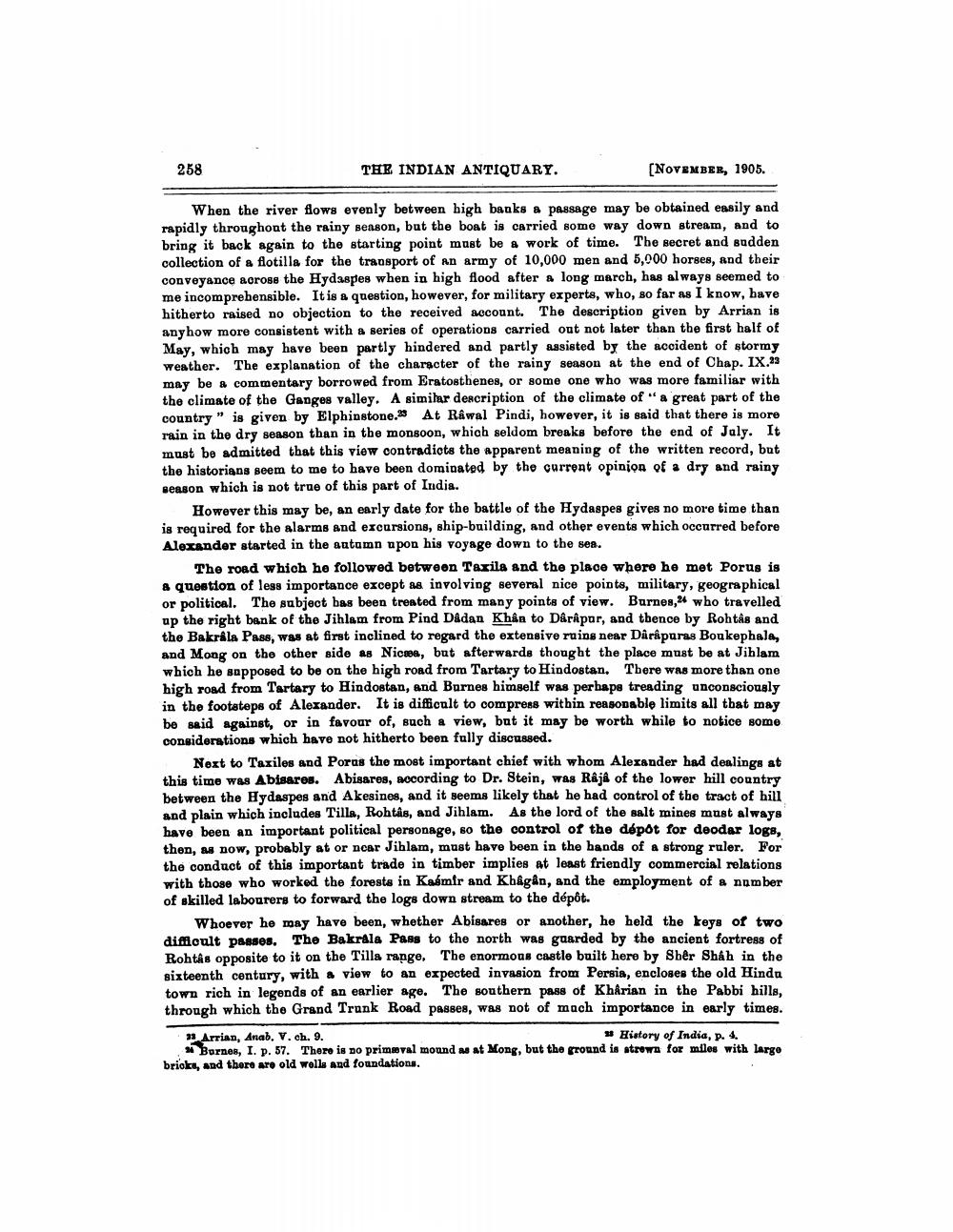________________
258
THE INDIAN ANTIQUARY.
(NOVEMBER, 1905.
When the river flows evenly between high bauksa passage may be obtained easily and rapidly throughout the rainy season, but the boat is carried some way down stream, and to bring it back again to the starting point must be a work of time. The secret and sudden collection of a flotilla for the transport of an army of 10,000 men and 5,000 horses, and their conveyance across the Hydaspes when in high flood after a long march, has always seemed to me incomprehensible. It is a question, however, for military experts, who, so far as I know, have hitherto raised no objection to the received account. The description given by Arrian is anyhow more consistent with a series of operations carried out not later than the first half of May, which may have been partly hindered and partly assisted by the accident of stormy weather. The explanation of the character of the rainy season at the end of Chap. IX.23 may be a commentary borrowed from Eratosthenes, or some one who was more familiar with the climate of the Ganges valley. A similar description of the climate of a great part of the country" is given by Elphinstone.2 At Rawal Pindi, however, it is said that there is more rain in the dry season than in the monsoon, which seldom breaks before the end of July. It must be admitted that this view contradicts the apparent meaning of the written record, but the historians seem to me to have been dominated by the current opinion of a dry and rainy season which is not true of this part of India.
However this may be, an early date for the battle of the Hydaspes gives no more time than is required for the alarms and excursions, ship-building, and other events which occurred before Alexander started in the autumn upon his voyage down to the sea.
The road which he followed between Taxila and the place where he met Porus is & question of less importance except as involving several nice points, military, geographical or political. The subject bas been treated from many points of view. Burnes, 24 who travelled up the right bank of the Jihlam from Pind Dadan Khân to Dârâpar, and thence by Rohtas and the Bakrála Pass, was at first inclined to regard the extensive ruins near Dârâparas Boukephala, and Mong on the other side as Nicæa, but afterwards thought the place must be at Jihlam which he supposed to be on the high road from Tartary to Hindostan. There was more than one high road from Tartary to Hindostan, and Barnes himself was perhaps treading unconsciously in the footsteps of Alexander. It is difficult to compress within reasonable limits all that may be said against, or in favour of, such a view, but it may be worth while to notice some considerations which have not hitherto been fully discussed.
Next to Taxiles and Poras the most important chief with whom Alexander had dealings at this time was Abisares. Abisares, according to Dr. Stein, was Raja of the lower hill country between the Hydaspes and Akesines, and it seems likely that he had control of the tract of hill and plain which includes Tills, Rohtas, and Jihlam. As the lord of the salt mines must always have been an important political personage, so the control of the dépot for deodar logs, then, as now, probably at or noar Jihlam, must have been in the hands of a strong ruler. For the conduct of this important trade in timber implies at least friendly commercial relations with those who worked the forests in Kasmir and Khâgân, and the employment of a number of skilled labourers to forward the logs down stream to the dépôt.
Whoever he may have been, whether Abisares or another, he held the keys of two diffioult passes. The Bakrala Pass to the north was guarded by the ancient fortress of Rohtas opposite to it on the Tilla range. The enormous castle built here by Sher Shah in the sixteenth century, with a view to an expected invasion from Persia, encloses the old Hindu town rich in legends of an earlier age. The southern pass of Kharian in the Pabbi hills, through which the Grand Trunk Road passes, was not of much importance in early times.
13 Arrian, Anab. V. ch. 9.
History of India, P. 4. Bornes, I. p. 57. There is no primeval mound as at Mong, but the ground is strowa for miles with largo brick, and there are old wolls and foundations.




